Potrebujeme váš súhlas na využitie jednotlivých dát, aby sa vám okrem iného mohli ukazovať informácie týkajúce sa vašich záujmov. Súhlas udelíte kliknutím na tlačidlo „OK“.
ASTM B822-10
Standard Test Method for Particle Size Distribution of Metal Powders and Related Compounds by Light Scattering
Automaticky preložený názov:
Štandardná skúšobná metóda pre Distribúcia veľkosti častíc kovových práškov a príbuzných zlúčenín pomocou rozptylu svetla
NORMA vydaná dňa 1.5.2010
Informácie o norme:
Označenie normy: ASTM B822-10
Poznámka: NEPLATNÁ
Dátum vydania normy: 1.5.2010
Kód tovaru: NS-8280
Počet strán: 4
Približná hmotnosť: 12 g (0.03 libier)
Krajina: Americká technická norma
Kategória: Technické normy ASTM
Kategórie - podobné normy:
Anotácia textu normy ASTM B822-10 :
Keywords:
laser diffraction, light scattering, metal powders, particle size distribution, powder metallurgy, Light scattering, Metal powders, Mie scattering, Multiple scattering, Particle analysis--metallic materials, Powder metallurgy (P/M) materials, Scattering (light), Fraunhofer diffraction instrumentation, ICS Number Code 13.300 (Protection against dangerous goods)
Doplňujúce informácie
| Significance and Use | ||||||||||
|
Reported particle size measurement is a function of both the actual particle dimension and shape factor as well as the particular physical or chemical properties being measured. Caution is required when comparing data from instruments operating on different physical or chemical parameters or with different particle size measurement ranges. Sample acquisition, handling, and preparation can also affect reported particle size results. It is important to recognize that the results obtained by this test method, or any other method for particle size determination using different physical principles, may disagree. The results are strongly influenced by the physical principles employed by each method of particle size analysis. The results of any particle sizing method should be used only in a relative sense; they should not be regarded as absolute when comparing results obtained by other methods. Light scattering theory has been available for many years for use in the determination of particle size. Several manufacturers of testing equipment now have units based on these principles. Although each type of testing equipment uses the same basic principles for light scattering as a function of particle size, different assumptions pertinent to application of the theory, and different models for converting light measurements to particle size, may lead to different results for each instrument. Therefore, the use of this test method cannot guarantee directly comparable results from different types of instruments. Knowledge of the particle size distribution of metal powders is useful in predicting the powder-processing behavior and ultimate performance of powder metallurgy parts. Particle size distribution is related closely to the flowability, moldability, compressibility, and die-filling characteristics of a powder, as well as to the final structure and properties of finished powder metallurgy (P/M) parts. This test method is useful to both suppliers and users of powders in determining the particle size distributions for product specifications, manufacturing control, development, and research. This test method may be used to obtain data for comparison between lots of the same material or for establishing conformance, as in acceptance testing. |
||||||||||
| 1. Scope | ||||||||||
|
1.1 This test method covers the determination of the particle size distribution by light scattering, reported as volume percent, of particulate materials including metals and compounds. 1.2 This test method applies to analyses with both aqueous and nonaqueous dispersions. In addition, analysis can be performed with a gaseous dispersion for materials that are hygroscopic or react with a liquid carrier. 1.3 This test method is applicable to the measurement of particulate materials in the range of 0.4 to 2000 μm, or a subset of that range, as applicable to the particle size distribution being measured. 1.4 The values stated in SI units are to be regarded as the standard. 1.5 This standard does not purport to address all of the safety concerns, if any, associated with its use. It is the responsibility of the user of this standard to establish appropriate safety and health practices and determine the applicability of regulatory limitations prior to use. |
||||||||||
| 2. Referenced Documents | ||||||||||
|
Podobné normy:
Historická
1.11.2013
Historická
1.5.2012
Historická
1.4.2011
Historická
1.11.2013
Historická
1.10.2013
Historická
1.4.2011
Odporúčame:
Aktualizácia technických noriem
Chcete mať istotu, že používate len platné technické normy?
Ponúkame Vám riešenie, ktoré Vám zaistí mesačný prehľad o aktuálnosti noriem, ktoré používate.
Chcete vedieť viac informácií ? Pozrite sa na túto stránku.


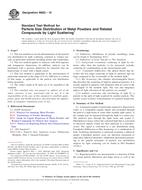
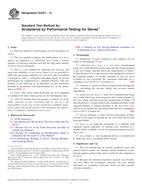 ASTM E2427-13
ASTM E2427-13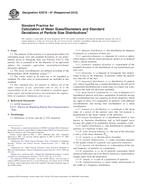 ASTM E2578-07(2012)..
ASTM E2578-07(2012)..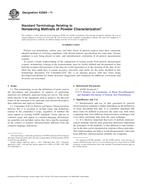 ASTM E2589-11
ASTM E2589-11 ASTM E2651-13
ASTM E2651-13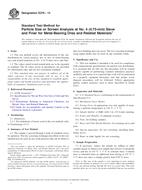 ASTM E276-13
ASTM E276-13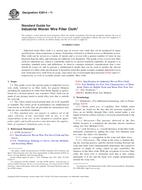 ASTM E2814-11
ASTM E2814-11
 Cookies
Cookies
